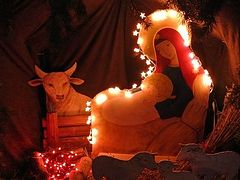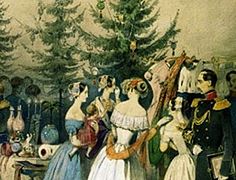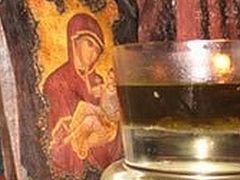 Spruce is an evergreen plant and therefore is a symbol of the Nativity. Pixabay.com
Spruce is an evergreen plant and therefore is a symbol of the Nativity. Pixabay.com
On January 7, the Orthodox world1 marks one of the most important dates in the Church calendar—the Nativity of Christ. Over time, this has become one of our most beloved feasts
How do Orthodox Christians celebrate the Birth of the Savior of the world? And why were birthdays once not celebrated at all? The Nizhny Novgorod branch of the Argumenty I Fakty newspaper posed these questions to Priest Alexei Pestretsov, a priest of the Cathedral of the All-Merciful Savior and the Procession of the Precious Wood of the Life-Giving Cross of the Lord (“the Old Fair Cathedral”) in Nizhny Novgorod, head of the press service of the ruling hierarch of the Nizhny Novgorod Diocese.
What’s more important?
—Why was December 25/January 7 chosen as the date of the Birth of Jesus Christ? Are there any sources extant confirming this date, or is it purely symbolic?
—There is symbolism in the date of the celebration of the Nativity of Christ—not in terms of fiction, but in terms of theological interpretation. The date of the Nativity in the Church calendar is counted from the date of another important Church feast—the Annunciation of the Most Holy Theotokos, when the Archangel Gabriel announced to the Virgin Mary that She was destined to become the Mother of the Savior of the world. We count nine months from this date and celebrate it as the Nativity of Christ.
In ancient times, even long before the Great Schism, the feast of the Nativity of Christ in some sense was combined with the feast of Theophany, or the Baptism of the Lord. This tradition is connected with the fact that in ancient culture—not only among Christians, but in general—there was no concept of birthdays. It was not the fact of a person’s birth that was marked, but the moment of his Baptism when a person entered the religious life of the community. But starting from the third and fourth century (this can be found in the writings of St. John Chrysostom) the Nativity began to be celebrated separately from Theophany.
When it comes to written sources, December 25 as the date of “the Birth of Christ in Bethlehem of Judea” was first mentioned by a Roman chronicler in 354 A.D.
The different dates of the Nativity for non-Orthodox and Orthodox (December 25 and January 7) are explained by different dating systems: the Gregorian and Julian Calendars.
—In the Western world, the Nativity of Christ is the principal festival of the Church calendar. For us such a festival is Pascha. Where does the discrepancy between them come from?
—In an absolute sense, for any Christian the most important thing is Pascha, when Christ rose from the dead and thus gave eternal life to all people.
But historically and culturally it has developed so that in Western Christianity the emphasis is on the Nativity. There is even a German proverb: “There is no nest higher than an eagle’s. There is no festival more important than Christmas.” This is due to the fact that non-Orthodox are more oriented towards the earthly life of Christ, God Who was incarnated in man: God loves me so much that He came down to earth.
In Orthodox Christianity, the emphasis is more on Christ—the Son of God. On Pascha, in His Passion, God calls man to ascend to Him in Heaven in order to become like Him and unite with Him.
The festive Nativity scenes
—When did Russia begin to celebrate the Nativity as a national holiday? Did it have any special traditions?
—Our country began to celebrate the Nativity of Christ immediately after the Baptism of Rus’. The earliest written evidence dates from the late seventeenth to early eighteenth centuries. At that time the tradition of arranging Nativity scenes and puppet shows became more common. The events associated with the Birth of Christ were played out with the help of puppets or actors.
In the nineteenth century, the tradition of decorating the Christmas tree with toys and candles was adopted by Russia from the West. The top of the tree was lit with the “Star of Bethlehem”, symbolizing the star that announced the Birth of Jesus Christ to the Magi.
—It is believed that the tradition of decorating the Christmas tree is pagan. Is it really so?
—There are different interpretations of the symbolism of the Nativity. For example, one legend has it that the Virgin Mary and Joseph covered the cave where Christ was born from the cold with fir branches [though it should be noted that fir trees do not grow in Palestine.—Trans.], hence the tradition.
In addition, fir is an evergreen plant, and Christ is a symbol of eternal life. This is also why it became one of the symbols of the Nativity.
It should be said that in pre-revolutionary Russia the main tradition of Christmas almsgiving was very developed, helping those in need so that everyone could celebrate the festival in an adequate manner.
—Is it true that on Christmas Eve (“Sochelnik”), January 6, you may not eat until the first star appears?
—Firstly, Christmas Eve is the last day of the Nativity Fast, a day of special abstinence and repentance.
Secondly, the tradition of not eating till the first star is associated with liturgical specifics. On this day the service begins in the evening, and people who for some reason could not be present in church knew that the service had begun, and it was already possible to eat. It was a guide.
Joy and light
—How should we celebrate the Nativity according to the Orthodox tradition?
—The feast is preceded by the Nativity Fast, which must be observed. It is gratifying to see that now more and more people are adhering to this rule.
The last week of the fast coincides with the celebration of the secular New Year. It is better to see the New Year in without much amusement and excesses in food. Just get together with the whole family and give gifts to children. In recent years it has become a tradition to celebrate services in churches right on New Year’s Eve, which you can attend. The Nativity, of course, also needs to be celebrated first in church, and then with the family. Nowadays, Nativity services are celebrated both at night and during the day.
The tradition of Christmas charity continues. For example, in the Church of the Vladimir Icon of the Mother of God in the Sormovsky (Sormovo) district of Nizhny Novgorod there is a so-called “wishing tree”. People put notes with their desires into a special box, and other parishioners fulfill these requests as much as they are able and bring gifts to church. Then the Dobry Pelikan (“Generous Pelican”) parish aid service delivers gifts to the addresses of those in need.
—Nowadays, New Year’s Day is more important to many than the Nativity of Christ. Should we swap the importance of these dates in the minds of people?
—Everyone chooses for himself. For Orthodox Christians the New Year is also an important time, when you should thank God for the days lived and ask for the blessing for the coming year. But for any believer the day of the Birth of the Savior of the world is certainly more important than the secular New Year.
—Christmastide (“Svyatki”) begins after the feast of Nativity. According to popular Slavic beliefs, during these days the material realm intersects with the invisible, and you can supposedly discover your fate through divination. What is the attitude of the Church to this tradition?
—The Church certainly doesn’t bless it. Svyatki in church language means "afterfeast"—the days (from January 7 to 19) when the Nativity of Christ is hymned in church. These are holy days, and you cannot profane them with the pagan tradition of divination—in fact, contact with dark forces. Only God knows what awaits us in the future, and it is better for people to come to church these days and ask the Lord for what they want.
But there is nothing wrong with the folk tradition of carolling. These processions with songs of praise for the Nativity, wishes of peace and good health to people bring Christmas joy and light.




